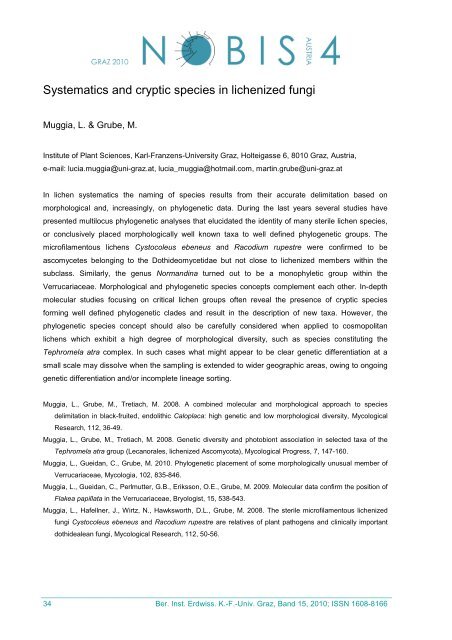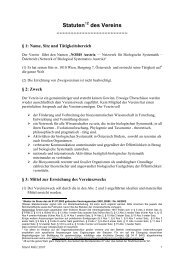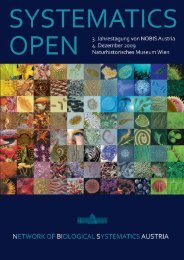4. Jahrestagung von NOBIS Austria 2. - 3. Dezember 2010
4. Jahrestagung von NOBIS Austria 2. - 3. Dezember 2010
4. Jahrestagung von NOBIS Austria 2. - 3. Dezember 2010
Create successful ePaper yourself
Turn your PDF publications into a flip-book with our unique Google optimized e-Paper software.
Systematics and cryptic species in lichenized fungi<br />
Muggia, L. & Grube, M.<br />
Institute of Plant Sciences, Karl-Franzens-University Graz, Holteigasse 6, 8010 Graz, <strong>Austria</strong>,<br />
e-mail: lucia.muggia@uni-graz.at, lucia_muggia@hotmail.com, martin.grube@uni-graz.at<br />
In lichen systematics the naming of species results from their accurate delimitation based on<br />
morphological and, increasingly, on phylogenetic data. During the last years several studies have<br />
presented multilocus phylogenetic analyses that elucidated the identity of many sterile lichen species,<br />
or conclusively placed morphologically well known taxa to well defined phylogenetic groups. The<br />
microfilamentous lichens Cystocoleus ebeneus and Racodium rupestre were confirmed to be<br />
ascomycetes belonging to the Dothideomycetidae but not close to lichenized members within the<br />
subclass. Similarly, the genus Normandina turned out to be a monophyletic group within the<br />
Verrucariaceae. Morphological and phylogenetic species concepts complement each other. In-depth<br />
molecular studies focusing on critical lichen groups often reveal the presence of cryptic species<br />
forming well defined phylogenetic clades and result in the description of new taxa. However, the<br />
phylogenetic species concept should also be carefully considered when applied to cosmopolitan<br />
lichens which exhibit a high degree of morphological diversity, such as species constituting the<br />
Tephromela atra complex. In such cases what might appear to be clear genetic differentiation at a<br />
small scale may dissolve when the sampling is extended to wider geographic areas, owing to ongoing<br />
genetic differentiation and/or incomplete lineage sorting.<br />
Muggia, L., Grube, M., Tretiach, M. 2008. A combined molecular and morphological approach to species<br />
delimitation in black-fruited, endolithic Caloplaca: high genetic and low morphological diversity, Mycological<br />
Research, 112, 36-49.<br />
Muggia, L., Grube, M., Tretiach, M. 2008. Genetic diversity and photobiont association in selected taxa of the<br />
Tephromela atra group (Lecanorales, lichenized Ascomycota), Mycological Progress, 7, 147-160.<br />
Muggia, L., Gueidan, C., Grube, M. <strong>2010</strong>. Phylogenetic placement of some morphologically unusual member of<br />
Verrucariaceae, Mycologia, 102, 835-846.<br />
Muggia, L., Gueidan, C., Perlmutter, G.B., Eriksson, O.E., Grube, M. 2009. Molecular data confirm the position of<br />
Flakea papillata in the Verrucariaceae, Bryologist, 15, 538-54<strong>3.</strong><br />
Muggia, L., Hafellner, J., Wirtz, N., Hawksworth, D.L., Grube, M. 2008. The sterile microfilamentous lichenized<br />
fungi Cystocoleus ebeneus and Racodium rupestre are relatives of plant pathogens and clinically important<br />
dothidealean fungi, Mycological Research, 112, 50-56.<br />
_____________________________________________________________________________<br />
34 Ber. Inst. Erdwiss. K.-F.-Univ. Graz, Band 15, <strong>2010</strong>; ISSN 1608-8166






